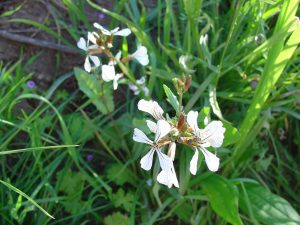
Eruca
Basic Information Common Name: Eruca Scientific Name: Eruca Native Habitat: Mediterranean region History / Discovery / Cultivator Eruca sativa, commonly known as arugula or rocket,
Common Name: Eruca
Scientific Name: Eruca
Native Habitat: Mediterranean region
Eruca sativa, commonly known as arugula or rocket, boasts a history deeply intertwined with the Mediterranean region and extending back to ancient times. Its cultivation can be traced back to the Roman era, where it was highly valued as a culinary and medicinal herb. Romans believed arugula possessed aphrodisiac properties and used it extensively in their cuisine, often combining it with other herbs and spices to create flavorful dishes and tonics. Historical records show that arugula was cultivated in gardens across Italy and beyond, and its popularity spread throughout the Roman Empire.
Following the decline of the Roman Empire, arugula continued to be cultivated in various parts of Europe and the Middle East. It was a staple green in many European gardens during the Middle Ages and Renaissance, enjoyed for its peppery flavor and nutritional value. Traditional herbal medicine also recognized its benefits, prescribing it for various ailments, including digestive issues and skin conditions. While not always as popular as other greens like lettuce or spinach, arugula maintained a steady presence in European and Middle Eastern cuisine for centuries.
The popularization of arugula in North America is a more recent phenomenon. While it was likely introduced earlier, its widespread availability and recognition as a gourmet green emerged in the late 20th century. Chefs and food enthusiasts began to rediscover its unique flavor profile, incorporating it into salads, pizzas, and other dishes. Its distinctive peppery taste appealed to a growing demand for more complex and flavorful culinary experiences. Farmers began to cultivate arugula specifically for the restaurant and retail markets, contributing to its increased availability and popularity.
Today, arugula is cultivated worldwide, with major producers including Italy, other Mediterranean countries, and the United States. It is recognized as a versatile ingredient enjoyed in a wide variety of cuisines, from traditional Italian dishes to modern fusion creations. Its popularity continues to grow as consumers seek out flavorful and nutritious greens, solidifying its place as a valued herb with a rich history. The plant’s ease of cultivation has further contributed to its widespread availability, allowing home gardeners and commercial growers alike to enjoy its peppery bounty. Furthermore, arugula’s ability to thrive in diverse climates has made it a globally accessible and appreciated green, celebrated for its culinary versatility and historical significance. The rediscovery and subsequent embrace of arugula highlight a fascinating journey from ancient Roman gardens to modern-day culinary innovation.
| Category | General Requirement | Notes |
|---|---|---|
| Light | Full Sun/Partial Shade | Requires at least 6 hours of sunlight for optimal growth. |
| Water | Regular | Keep soil consistently moist, especially during hot weather. |
| Humidity | Average | No special humidity requirements. |
| Temp. Range | 50-75°F (10-24°C) | Prefers cooler temperatures, tolerates light frost. |
| Soil Type | Well-draining | Requires well-draining soil rich in organic matter. |
| Fertilizer | Light Feeding | Apply a balanced fertilizer every few weeks. |
| Toxicity | Non-toxic | Generally considered non-toxic to humans and pets. |
Arugula is adapted to thrive in the Mediterranean climate, characterized by hot, dry summers and mild, wet winters. Its peppery flavor is thought to be a defense mechanism against herbivores. It’s a relatively fast-growing plant, allowing it to quickly capitalize on favorable growing conditions. Its ability to tolerate light frost extends its growing season in cooler climates.
Arugula is most commonly propagated by seed. Seeds can be sown directly into the garden or started indoors. It readily self-seeds if allowed to flower. Because of the fast growth, successive sowing every few weeks can allow for continous harvests of the leaves.
Arugula is generally considered non-toxic. However, individuals with allergies to other members of the Brassicaceae family (e.g., mustard, cabbage) may experience allergic reactions. In large quantities, it may cause mild digestive upset due to its high fiber content. It also contains glucosinolates, which can interfere with thyroid function in very high doses, but this is rarely a concern with normal consumption.
Arugula itself is not rare. However, specific cultivars with unique flavor profiles or disease resistance may be less commonly available. Wild arugula species might be considered rarer than the cultivated varieties.
The value of arugula is primarily determined by its freshness and quality. Organic arugula typically commands a higher price. The specific variety or cultivar can also influence its value, with some having a more desirable flavor or appearance.

Basic Information Common Name: Eruca Scientific Name: Eruca Native Habitat: Mediterranean region History / Discovery / Cultivator Eruca sativa, commonly known as arugula or rocket,

Basic Information Common Name: Arugula Scientific Name: Eruca vesicaria Native Habitat: Mediterranean Region History / Discovery / Cultivator Arugula, scientifically known as Eruca vesicaria, boasts
